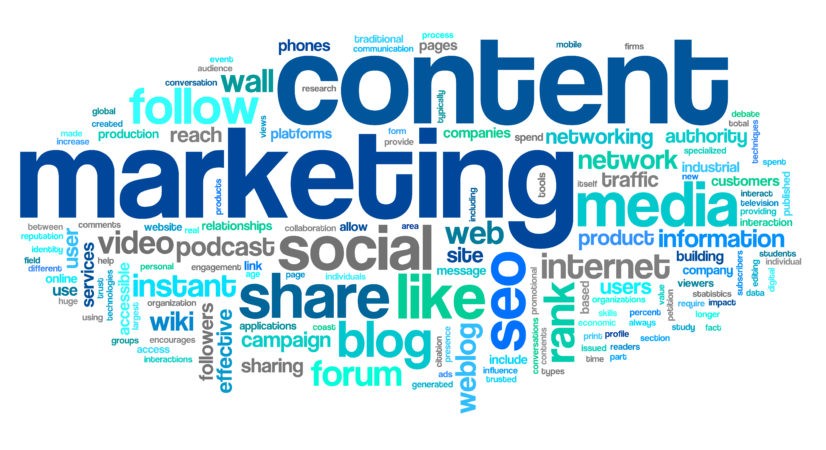When it comes to web traffic and visibility, content marketing is your friend. A strategy for this can be difficult to implement, so breaking it up into digestible stages can help you stay focused without biting off more than you can chew.
Your first step in creating a clear blog and content strategy is identifying your customer’s journey.
The Customer Journey and Content Marketing
Commonly called “the conversion funnel” in marketing, we break the steps in this journey up between awareness, search, research, purchase, and experience. (Variations on this include “awareness, interest, desire, action,” “awareness, consideration, preference, intent, purchase,” or others, but they all reflect the same thing.)
It begins with awareness. And the issue is as follows — how do you raise awareness if no one’s aware that they should be aware? That’s a convoluted way of saying it’s kind of a chicken-and-egg scenario. If people are not even aware of your brand, how do you organically lead users to that first step? This question is why content marketing is so valuable.
While unaware users won’t search for you, writing content with relevant keywords for which they will be searching leads them to you. A sidenote — and this should go without saying — is quality content is key, not just clickbait-y or valueless pieces that are clear attempts to foist as many keywords into a space as possible. Here’s a more in-depth post of ours on why quality matters.
As a starting point, we recommend identifying all the ways your customers search for products or services like yours. After this, it’s smart to create a unique page dedicated to each of these queries on which you can include relevant, helpful information. For closely related terms, however, we advise against making a unique page for each since that makes your site convoluted and redundant; instead, create a page for one term and include SEO tags for variations of the keyword and related terms.
The next stop in our application of the customer journey is the search phase.

Example of Google Search
This phase is where having a search engine optimized website is valuable; make sure that your site’s infrastructure and layout is such that people can find your products when searching for them! The more users have to scroll or scour the search engine results page, the less likely they are to get to you — and they’re less likely by a lot. We have more information on search engine optimizing on this post, so that you can avoid that scenario.
After search is research. Once people are aware of you and have searched for your products, they’ll then do their research between you and your competitors. When they reach this stage, you need to be able to present an argument — and you need that argument to be as easy for them to find as possible. Luckily, the more quality content you create to make your “argument,” the more visible you become. Two birds with one stone!
When you produce content that puts your product’s superiority, uniqueness, and other valuable qualities on display, you are both helping convince users to choose you and increasing the likelihood people will see you.
There are a lot of ways to fulfill this task. Product reviews and tests; interactive videos or GIFs are great for highlighting clothing and lifestyle products; written content can cover endless angles. The media you use is up to you!

Example of Product Review from Urban Outfitters
The next part of the customer journey in this case is the purchase. While this is obviously the most critical part of your role as a business, it is ironically the least significant step where content marketing is concerned. In fact, having a bunch of consumable content coming up during the purchasing process could act as a distracting barrier for many and hinder their conversion. So, really, the main thing to remember about purchasing is to ensure the purchasing experience is as easy as possible. You do not want people abandoning if they’ve gotten this far.
The last phase of the customer journey is the product experience itself.
Some conversion funnel models do not include this phase, but we like to emphasize its importance. Your goals when focusing on this step should be to increase brand loyalty through the product itself, get user reviews to increase your chance of closing on future users’ purchases, and more.
Besides the quality of the product itself (without which, of course, you can’t do much — but that’s beyond the marketing team), you can help make the best of users’ experience with your product or service via written or video content that supports them. This can take many forms; some common ones include a comprehensive FAQ page, blog posts on fixes to common problems, testimonials from other users, or support documents. However, you choose to approach this stage, it requires you to be in tune with your customer complaints and praises for each of your products so that you can offer a helpful response or support.
This “experience” stage is probably the one that overlaps with the most other departments besides marketing such as customer service, R&D, production, etc., but doing a stellar job on the content marketing side can significantly boost users’ perception of all these aspects of your product and team.
Beyond the Customer Journey — “Lifestyle” Posts
Although these sorts of blog posts apply in ways to both the awareness and experience phases of the customer journey, they deserve a section of their own. While “lifestyle” has become a buzzword that sometimes feels superficial and shallow — how many lifestyle blogs or “influencers” have you rolled your eyes at? — creating consistent content that relates to topics adjacent to your product is really valuable for online visibility. And, because we don’t exactly have another label for this, we’ll just keep calling it “lifestyle” content.
This kind of content does not need to be directly related to your product. Instead, its value is about targeting keywords within your industry or the lifestyle related to your product or brand while bringing eyes onto your site. These sorts of posts are often made with the intent of being distributed on social channels like YouTube, Instagram, Facebook, and Twitter. While they have SEO value, these posts should be particularly optimized for social media because they’re such a big opportunity for site traffic.

Example of Facebook Blog
In the end, a blog content marketing strategy will take you far. That plus an eye on each of the stages of the customer journey will go even further. When you optimize your site and content for each of those stages and craft a good blog experience, you can repackage the latter for social distribution while having the peace of mind that your site itself is at its best.




